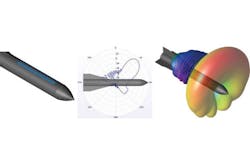Simulation Software Optimizes Missile Antennas
This file type includes high resolution graphics and schematics when applicable.
Antenna arrays are making themselves useful in applications ranging from biomedical to radar. Such diverse applications place the arrays in environments that are far from their planar performance ideal. To effectively predict and optimize the behavior of non-planar antenna arrays, powerful 3D simulators could be used in the initial design stages. Remcom has released an application note investigating this option titled, “Conformal Antenna Array Design on a Missile Platform.”
The example in the application note is a 12-×-1 antenna array mounted on the side body of a theoretical missile. The design must overcome the challenging constraints of having a radiative body as an antenna-array mounting surface while meeting airborne weaponry standards. The specifications of operation for this demonstration include a center frequency of 2.4 GHz, a main beam gain greater than 10 dBi, and side-lobe levels that are less than 20 dB below the peak gain figures.
A planar conformal antenna is required to meet the surface requirements of the missile body. A parametric investigation is performed to optimize the patch antenna array for performance. The array is then bent to the missile’s body shape for aerodynamics. Such bending shifts the operating frequency close to 2.45 GHz. After a slight patch diameter variation, however, the operating frequency again conforms to the specification. Scripts from Remcom’s library are used to choose the array amplitude and phase in order to meet the sidelobe and main gain figures.
The antenna array is then integrated into a 3D model of the missile body. Simulations are run using a variety of computer hardware permutations to demonstrate the time enhancements of using multicore graphical processing units (GPUs) for simulation. Using a single Intel Core i7, the simulation required 3 hrs. and 13 min. of simulation time. In contrast, using a single Nvidia Tesla C2070 GPU brought the simulation time down to 29 min. and 40 sec. Six Nvidia GPUs lowered the simulation time to 7 min. and 20 sec. This example demonstrates the simulation-time performance that can be acquired from GPU processing using 3D electromagnetic simulation software that can leverage the CUDA environment.
REMCOM, 315 South Allen St., Ste. 416, State College, PA 16801; (814) 861-1299
This file type includes high resolution graphics and schematics when applicable.
About the Author
Jean-Jacques DeLisle
Jean-Jacques graduated from the Rochester Institute of Technology, where he completed his Master of Science in Electrical Engineering. In his studies, Jean-Jacques focused on Control Systems Design, Mixed-Signal IC Design, and RF Design. His research focus was in smart-sensor platform design for RF connector applications for the telecommunications industry. During his research, Jean-Jacques developed a passion for the field of RF/microwaves and expanded his knowledge by doing R&D for the telecommunications industry.


